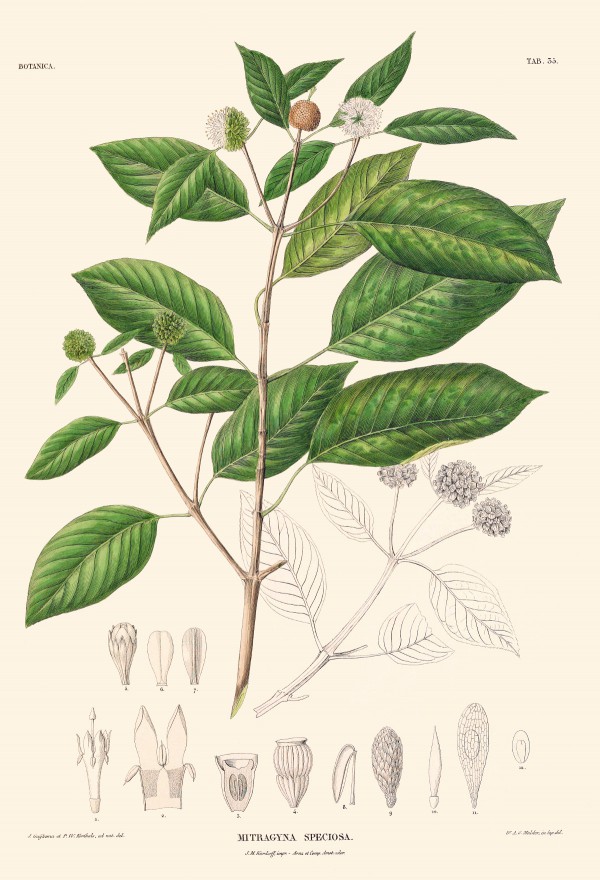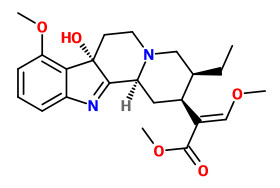Mitragyna speciosa Korth. - Rubiaceae - kratom, kratum, Kratombaum, Kratom
Evergreen tree, up to 25m tall, native to Southeast Asia; leaves opposite, dark green, elliptic-ovate acuminate, up to 14cm long; flowers yellow, in round terminal clusters. https://en.wikipedia.org/wiki/Mitragyna_speciosa
„The leaves of a tropical plant, Mitragyna speciosa KORTH (Rubiaceae), have been traditionally used as a substitute for opium. Phytochemical studies of the constituents of the plant growing in Thailand and Malaysia have led to the isolation of several 9-methoxy-Corynanthe-type monoterpenoid indole alkaloids, including new natural products. The structures of the new compounds were elucidated by spectroscopic and/or synthetic methods. The potent opioid agonistic activities of mitragynine, the major constituent of this plant, and its analogues were found in in vitro and in vivo experiments and the mechanisms underlying the analgesic activity were clarified. The essential structural features of mitragynines, which differ from those of morphine and are responsible for the analgesic activity, were elucidated by pharmacological evaluation of the natural and synthetic derivatives. Among the mitragynine derivatives, 7-hydroxymitragynine, a minor constituent of M. speciosa, was found to exhibit potent antinociceptive activity in mice.“
[Chemistry and pharmacology of analgesic indole alkaloids from the rubiaceous plant, Mitragyna speciosa., Takayama, H., Chemical and Pharmaceutical Bulletin, 52(8), 2004, 916-928] http://catbull.com/alamut/Bibliothek/Mytragina%20speciosa_pdf.pdf
By screening of M. speciosa products in the drug market, the content of mitragynine ranged from 1% to 6%, and that of 7-OH-mitragynine from 0.01% to 0.04%.
[Simultaneous analysis of mitragynine, 7-hydroxymitragynine, and other alkaloids in the psychotropic plant “kratom”(Mitragyna speciosa) by LC-ESI-MS., Kikura-Hanajiri, R., Kawamura, M., Maruyama, T., Kitajima, M., Takayama, H., Goda, Y., Forensic toxicology, 27(2), 2009, 67-74]
„Kratom has been widely used in Southeast Asia for hundreds of years. In Thailand, kratom use typically
involves ingestion of the plant’s raw leaves or consumption of teas that are brewed or steeped from the leaves. Kratom leaves are used for their complex, dose-dependent pharmacologic effects. Low to moderate doses (1-5 g) of the leaves reportedly produce mild stimulant effects that enable workers to stave off fatigue. Moderate to high doses (5-15 g) are reported to have opioid-like effects. At these doses, kratom has been used for the management of pain, diarrhea, and opioid withdrawal symptoms, as well as for its properties as a euphoriant. Very high doses (>15 g) of kratom tend to be quite sedating and can induce stupor, mimicking opioid effects… .. Most of the opioid-like activity of kratom has been attributed to the presence of the indole alkaloids, mitragynine and 7-hydroxymitragynine. Both compounds have been shown to have analgesic and antinociceptive effects in animals, although 7-hydroxymitragynine is more potent… in Southeast Asia, it has long been recognized that individuals will seek out and abuse kratom for its euphoric and mind-altering effects and that chronic users can become tolerant of, physically dependent on, and addicted to kratom. Kratom addiction is considered such a problem that many Southeast Asian countries have outlawed the use of kratom.“
[Pharmacology of kratom: an emerging botanical agent with stimulant, analgesic and opioid-like effects., Prozialeck, W.C., Jivan, J.K., Andurkar, S.V., The Journal of the American Osteopathic Association, 112(12), 2012, 792-799] http://jaoa.org/article.aspx?articleid=2094342
„The clinical effects of Kratom are dose-dependent. At low doses, Kratom produces a stimulant effect; at higher doses, the opioid effect predominates… M. speciosa Korth is a plant made up of more than 25 alkaloids that vary in specific composition depending on the plant's geographical location… Mitragynine is approximately 13 times more potent than morphine, while 7-hydroxymitragynine (a minor component of M. speciosa Korth) is four times more potent than mitragynine… A withdrawal syndrome has also been described in chronic Kratom users reporting irritability, yawning, rhinorrhea, and diarrhea. One contemporary case report describes a 44-year-old patient who manifested the following signs of withdrawal from Kratom: “anxiety, restlessness, tremor, sweating, and cravings for the substance”…“
[Rosenbaum, Christopher D., Stephanie P. Carreiro, and Kavita M. Babu. „Here today, gone tomorrow… and back again? A review of herbal marijuana alternatives (K2, Spice), synthetic cathinones (bath salts), kratom, Salvia divinorum, methoxetamine, and piperazines.“ Journal of Medical Toxicology 8.1 (2012): 15-32] https://www.ncbi.nlm.nih.gov/pmc/articles/PMC3550220/pdf/13181_2011_Article_202.pdf
„Neither Mitragyna speciosa nor mitragynine or other alkaloids from the plant are listed in any of the Schedules of the United Nations Drug Conventions. Mitragyna speciosa and/or mitragynine and/or 7-hydroxymitragynine have been reported to be controlled in at least 12 EMCDDA countries. Denmark, Estonia, France, Italy, Latvia, Lithuania, Poland, Portugal, Romania, Finland, Sweden, Turkey. Other countries that control kratom under their narcotic law are Australia, Malaysia, Myanmar and Thailand. New Zealand controls Mitragyna speciosa and mitragynine under its Medicines Amendment Regulations. In the USA, kratom is not controlled though considered as a ’drug of concern’.“
Kratom drug profile (EUDA) retrieved 15 July 2025

Mitragyna speciosa, Korthals, P.W., Kruidkunde [Verhandelingen over de natuurlijke geschiedenis der Nederlandsche overzeesche bezittingen; deel Botanie], t.35 (1839-1842)
http://botanicalillustrations.org/species.php?id_species=675598
„Mitragyna Speciosa tree“, author: ThorPorre Wikimedia Commons
CC BY-SA 3.0

